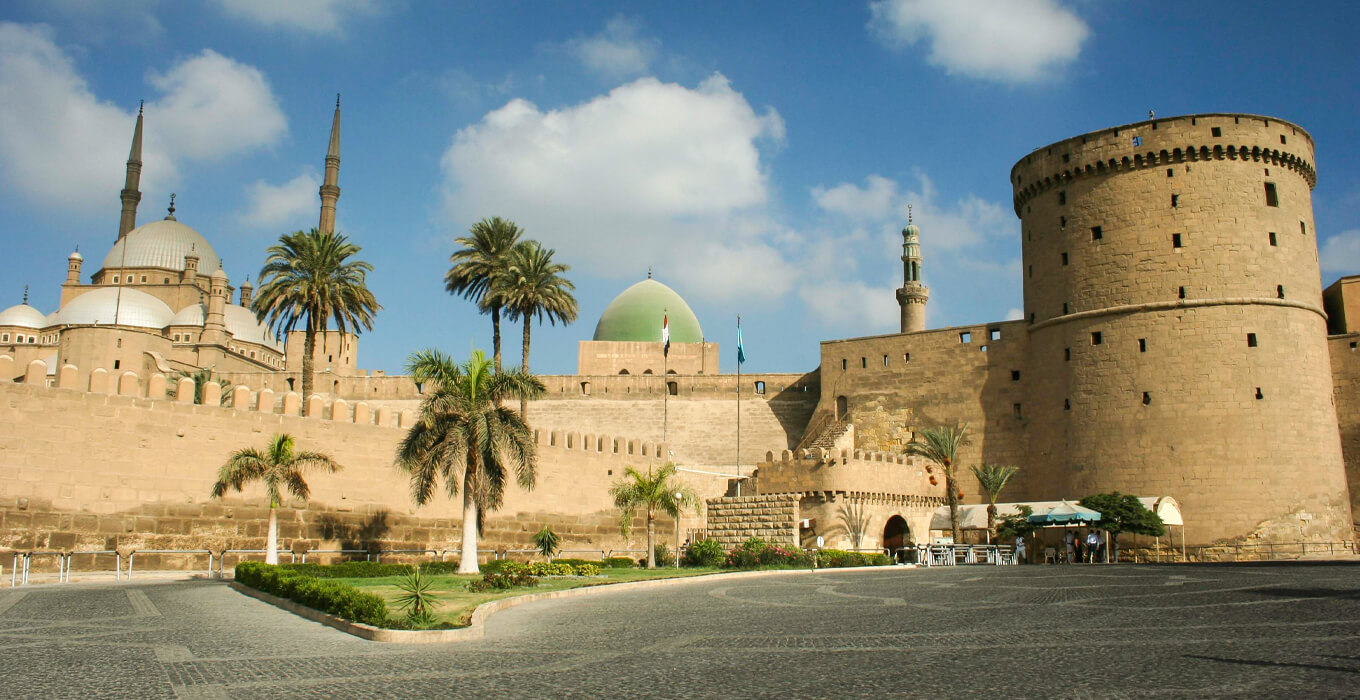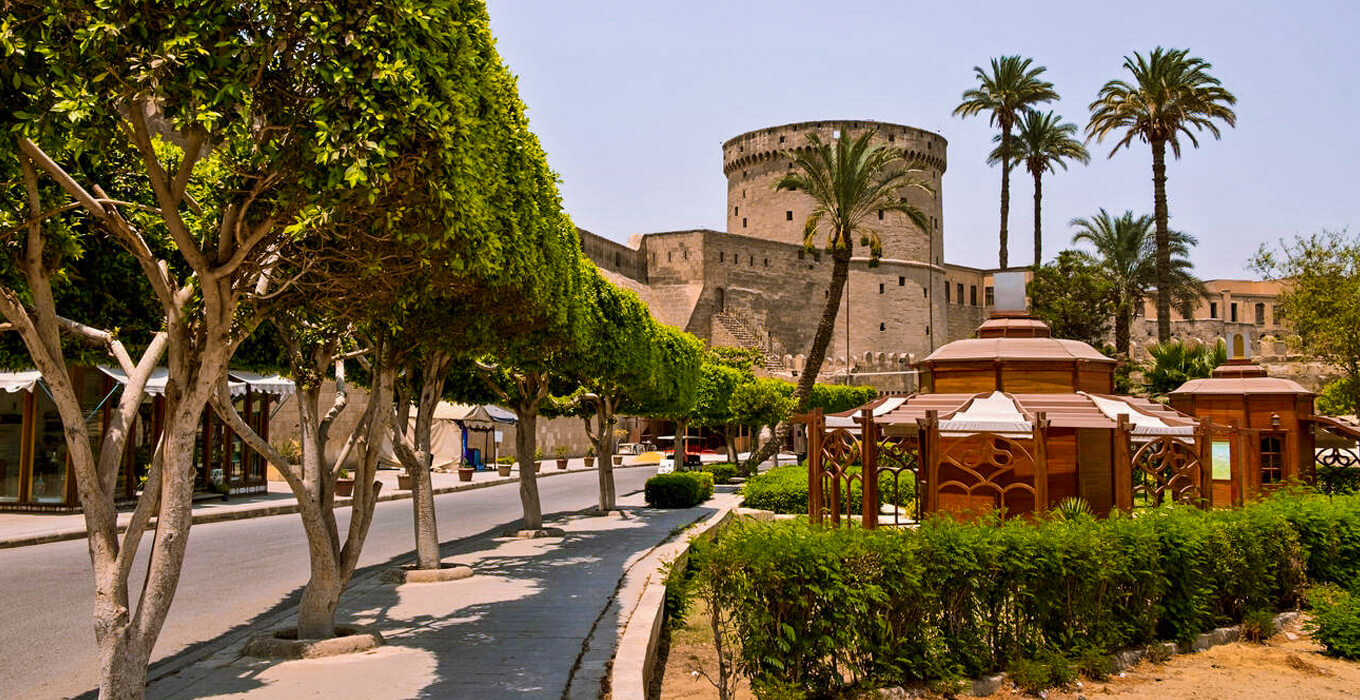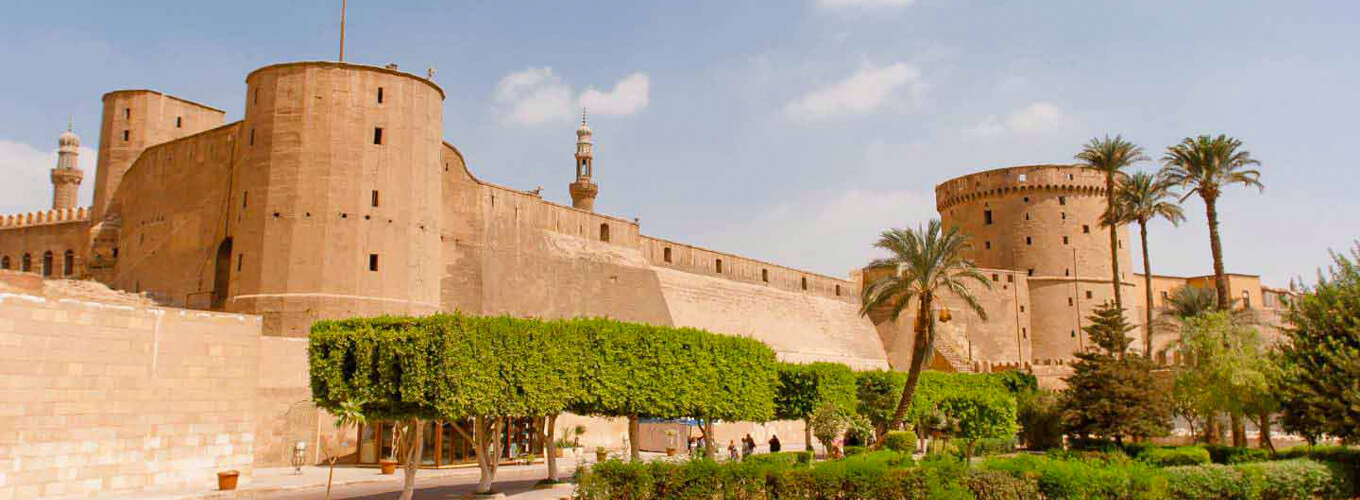Saladin Citadel in Cairo sits high on the Mokattam Hills in Cairo. It’s a symbol of Egypt’s deep history and amazing architecture. But what mysteries does this old fortress keep? Let’s explore the story of this UNESCO World Heritage Site.
Key Takeaways
- Saladin Citadel in Cairo is a famous medieval Islamic fortress in Cairo, Egypt. It was built by the Ayyubid sultan Saladin between 1176 and 1183 CE.
- This fortress was the center of government and home of Egyptian leaders for almost seven hundred years. It was key in defending Egypt against many attacks.
- Its spot on the Mokattam Hills gives visitors amazing views of Cairo. It’s a top spot for those who love history and sightseeing.
- The Citadel shows off beautiful architecture with places like the Muhammad Ali Pasha Mosque and the Al-Nasir Muhammad Mosque. These buildings mix Islamic and Ottoman styles.
- Today, the Citadel has museums like the Egyptian National Military Museum, the Royal Carriages Museum, and the Police Museum. These museums help visitors learn more about Egypt’s history and culture.
Introduction to Saladin Citadel in Cairo
Brief History and Significance
The Citadel of Saladin is a key monument in Islamic Cairo. It was built by Ayyubid Sultan Salah al-Din al-Ayyubi, also known as Saladin, from 1176 to 1183 AD. This fortress was the government seat in Egypt for almost 700 years.
It’s located on the Muqattam Hills. This spot made it a strong defensive spot. It also gave amazing views of the city.
Location and Panoramic Views
The Citadel sits on a hill in Cairo, Egypt, near the Muqattam Hills. Its high spot made it hard to attack. It looked over the city and the areas around it.
From the Citadel, you can see the historic Cairo. You’ll see the Nile River, the Pyramids of Giza, and the lively neighborhoods. This place shows the beauty of medieval times.
Architectural Masterpiece of Medieval Islamic Engineering
The Citadel of Saladin is a true marvel in architecture. It shows the amazing skills of medieval Islamic engineers and builders. Built in the Hegira 6th–7th century / AD 12th–13th century, it used limestone from the Muqattam Hills.
Its strong walls and towers were key to its defense. This made it a top military project of its time.
The Citadel covers about seven hectares and sits on a hill. This spot gave it a great view of the area. The moat, ordered by al-Malik al-Zahir Ghazi, was 22 meters deep. This added to its defense.
The Citadel’s design shows how Islamic building styles changed over time. It was influenced by the Zangid, Ayyubid, and Mamluk periods. Important people like Nur al-Din Mahmud bin Zangi and al-Malik al-‘Aziz Muhammad helped build and update it.
The Citadel’s entrance is a key example of Ayyubid defense. It has a ramp, U-shaped corridor, and towers to control an attack. The Lion Gate and Serpent Gate show power and protect certain areas.
The Citadel of Saladin is a symbol of medieval Islamic architecture and engineering. Its strong defenses, strategic spot, and changes over time make it a masterpiece. It’s a key part of Citadel of Saladin Architecture, Medieval Islamic Fortress, and Defensive Architecture Cairo.
Saladin’s Original Construction in the 12th Century
The Citadel of Saladin sits on Cairo’s Moqattam Hills. It was built from 1176 to 1182 CE by the famous Ayyubid Sultan Saladin. He wanted it to protect the city from Crusader attacks. It also became the center of government for his Ayyubid rule.
Defensive Fortifications against Crusaders
Baha al-Din Qaraqush, Saladin’s top eunuch, led the building of the first fortress. This is part of the Northern Enclosure today. The Citadel was made with strong defensive fortifications. These included walls, towers, and smart placement to stop Crusader attacks.
Materials and Labor Utilized
- The main building materials were limestone from the Muqattam Hills.
- Materials from minor pyramids at Giza and Abusir were also used.
- Christian prisoners of war helped build the Citadel after Saladin’s victories.
Saladin’s careful planning made the Citadel a lasting defensive stronghold and power center during the Ayyubid time.
Expansions and Modifications by Successive Rulers
The Citadel of Saladin in Cairo, Egypt, has a long history. It was built by Sultan Saladin in the 12th century. Over time, it was improved by Ayyubid and Mamluk rulers.
Ayyubid Modifications
After Saladin built the Citadel, his Ayyubid family made it stronger. Sultan al-‘Adil, his brother, helped finish the Citadel. By 1238, under al-Kamil, it was fully built.
The Ayyubids made the Citadel stronger. They made sure it could fight off threats.
Mamluk Contributions
Then, the Mamluks took over the Citadel. They made big changes, especially under Sultan al-Nasir Muhammad in the 14th century. The Mamluks added new buildings and defenses.
The work of the Ayyubids and Mamluks made the Citadel what it is today. Each ruler added something special to this famous place. The Citadel’s story shows its lasting importance in Islamic history.

Muhammad Ali Pasha’s Renovations in the 19th Century
In the early 19th century, Muhammad Ali Pasha led a big change at the Citadel of Saladin. He wanted to make the historic fortress new again. His big project changed the Muhammad Ali Pasha Citadel forever.
New Palaces and Monuments
Muhammad Ali Pasha tore down many old buildings. He built new palaces and monuments instead. These new buildings changed the Citadel’s look.
The Mosque of Muhammad Ali Pasha is a key example of this change. It’s also called the Alabaster Mosque. Built from 1830 to 1848, it’s one of Cairo’s biggest mosques.
This mosque can hold 10,000 people. It’s 52 meters long and 82 meters wide. The main dome is 41 meters high, and the minarets reach 82 meters.
There’s more than just the mosque. The al-Gawhara Palace, or Bijou Palace, was built in 1814. It was made by artists from many countries. This shows Muhammad Ali Pasha’s dream of creating something amazing.
Key Monuments and Attractions within the Citadel
The Citadel of Saladin is full of monuments and attractions that take you back in time. You’ll see the Mosque of Muhammad Ali Pasha, the Al-Nasir Muhammad Mosque, and museums and palaces. They show Egypt’s rich history.
Mosque of Muhammad Ali Pasha
The Mosque of Muhammad Ali Pasha stands tall in the Citadel. Built from 1830 to 1848, it has twin minarets that go up 52 meters. The dome is also 52 meters high. It has an Ottoman design and beautiful details inside.
Al-Nasir Muhammad Mosque
The Al-Nasir Muhammad Mosque is from the early 14th century. It was made by Sultan Al-Nasir Muhammad. The mosque has a big courtyard with columns from old Egyptian buildings.
Museums and Palaces
The Citadel also has museums and palaces that tell more about Egypt’s history and culture. You can visit the Police Museum, the Al-Jawhara Palace Museum, and the Military Museum. Each museum shows a different part of the country’s past.
There’s also the Palace of Jewels, built in 1814 in Ottoman style. The Harem Palace of Muhammad Ali, now the Egyptian Military Museum, is another great place to see.
| Attraction | Highlights | Opening Hours |
| Mosque of Muhammad Ali Pasha | Impressive 52-meter-high dome and twin minarets | 9:30 a.m. to 4:00 p.m. |
| Al-Nasir Muhammad Mosque | Courtyard with ancient Egyptian supporting columns | 9:30 a.m. to 4:00 p.m. |
| Police Museum | Exhibitions on the history of the Egyptian police force | 9:30 a.m. to 4:00 p.m. |
| Military Museum | Showcases the history of the Egyptian military | 9:30 a.m. to 4:00 p.m. |
| Al-Jawhara Palace Museum | Housed in the Palace of Jewels, a 19th-century Ottoman-style palace | 9:30 a.m. to 4:00 p.m. |
Saladin Citadel in Cairo’s Strategic Importance
The Citadel of Saladin was a key defensive spot and the top spot for leaders in Egypt. It was the heart of government and home to the rulers for almost 700 years. It sits high on the Muqattam Hills, ready to guard Cairo from threats like Crusader attacks.
Defensive Stronghold and Seat of Power
The Citadel was built strong and in a smart spot. It could hold off many attacks and was a key spot for the Ayyubid, Mamluk, and Muhammad Ali dynasties. Until the 19th century, it was where the government sat, before moving to the Abdeen Palace in downtown Cairo.
In 1976, the Citadel was named a UNESCO World Heritage Site. This showed its big role in history and culture. For almost 700 years, it was the government’s base, proving its Citadel Seat of Power status.
“The Citadel of Saladin was a strong Citadel Defensive Stronghold, keeping Cairo safe for centuries.”
The Citadel was taken over just once, by the British in the 20th century, when they made it a military base. This shows how well-built and smartly placed the Citadel was, as a Citadel of Saladin Strategic Importance.
| Fact | Value |
| Citadel’s UNESCO World Heritage Site Status | Declared in 1976 |
| Citadel’s Tenure as Seat of Egyptian Government | Almost 700 years |
| Citadel’s Occupations by Invading Forces | Only once by the British in the 20th century |
The Citadel as a World Heritage Site
The Citadel of Saladin is a key landmark in Historic Cairo. It was made a Citadel of Saladin World Heritage Site by UNESCO in 1976. This was part of the Citadel Historic Cairo designation.
This fortress is known for its amazing architecture and history. It was a key place of power for many years. The Citadel’s UNESCO Citadel UNESCO Designation shows its great value to the world.
“The Citadel of Saladin is a true architectural masterpiece, showcasing the ingenuity and craftsmanship of medieval Islamic engineering. Its designation as a UNESCO World Heritage Site is a testament to its enduring significance.”
Being a Citadel of Saladin World Heritage Site helps protect its history. Visitors can see its big walls, beautiful mosques, and stories from the past.
The Citadel UNESCO Designation makes it a top spot in Egypt. It shows the Citadel’s lasting impact and beauty. Everyone who visits is moved by its history.

Visiting the Citadel: Tips and Guided Tours
The Citadel of Saladin is a historic fortress in Cairo. It lets visitors see ancient wonders of Egypt. You can explore the Citadel’s architecture, history, or enjoy city views in different ways.
Exploring the Ancient Fortress
The Citadel of Saladin has a big wall with towers. It shows the fortress’s strategic role. You can walk through historic streets, see the Muhammed Ali Mosque, and enjoy Cairo’s views from up high.
- Entry tickets to the Citadel of Saladin cost EGP 20 for Egyptians and Arab tourists, and EGP 140 for other foreigners.
- The original structure of the Citadel was commissioned by Saladin and dates back to 1176-1183 AD.
- The Citadel has served as the “administrative” home of the Egyptian rulers for more than 700 years.
Recommended Guided Tours
For a deeper understanding of the Citadel, consider a guided tour. An expert can share insights about the sights and features.
| Tour Option | Duration | Price |
| Standard Guided Tour | 2 hours | $20 per person |
| Extended Guided Tour | 3 hours | $30 per person |
| Evening Citadel Tour | 1.5 hours | $25 per person |
With a knowledgeable guide, visitors can appreciate the Citadel’s history and architecture more deeply.
Cultural and Historical Significance of the Citadel
The Citadel of Saladin in Cairo is more than just a beautiful building and a UNESCO site. It is deeply important to Egypt’s culture and history. This fortress has seen key events from its start to the end of the Muhammad Ali Dynasty.
Witnessing Significant Events in Egyptian History
For nearly 700 years, the Citadel was the home of Egypt’s leaders. It shows the country’s rich history and its importance in Islamic civilization. Many big events happened here, changing Egyptian history.
- The Citadel’s towers, like Burg al-Ramla and Burg al-Haddad, were built in 1184 AD. They show the Citadel’s Citadel Cultural Significance as a strong defense against Crusaders.
- Later, it was barracks for the Burji Mamluks under Sultan Qalawun. This made it even more important as a military site.
- Circassian Mamluk sultans like Jaqmaq, Qaytbay, and al-‘Adil Tumanbay did more work on it. This is shown on marble panels at the entrance, highlighting the Citadel Egyptian History.
The Citadel has seen many important moments in Citadel Egyptian History. Its lasting presence and role as a witness make it a key landmark. It still draws visitors from all over the world.
Conclusion
The Citadel of Saladin is a key example of medieval Islamic architecture and engineering. Built in the 12th century by Sultan Saladin, it was a key defense spot and a place of power in Egypt. Over time, it grew into a mix of mosques, museums, and historic sites.
Its spot on a hill in Cairo made it a great place to see what was happening below. Its strong walls and long history as a place of power make it a UNESCO World Heritage Site. People who visit can learn about its history, see amazing architecture, and understand Egypt’s past.
Visitors from all over the world come to see the Citadel of Saladin. It shows the lasting impact of the Ayyubid dynasty and the great achievements of medieval Islamic civilization. This historic site is a treasure in Cairo, offering a special experience for everyone who visits.
Read our related articles:


